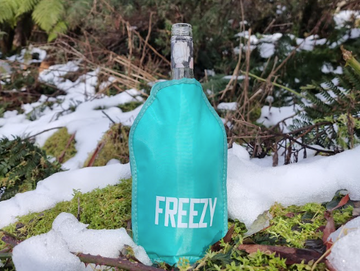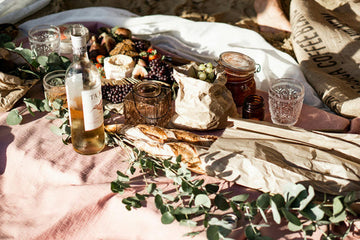Wine is one of those drinks we all seem to enjoy, whether we're curled up on a chilly winter night or soaking up the sun on a warm summer afternoon. But did you know that the right serving temperature can completely transform its taste, aroma, and texture? From crisp whites to robust reds and sparkling wines that dance on the palate, the right temperature guarantees every sip is an experience to savour.
This comprehensive guide will walk you through everything you need to know about wine temperatures, including ideal conditions for serving, how to choose the perfect glass, and tips for proper storage. Join us as we take a look at how you can enjoy wine at its best!
Understanding Wine and Temperature
Why Does Wine Temperature Matter?
The temperature at which you serve wine greatly impacts its flavour, aroma, and mouthfeel. A wine served too warm can feel flat, exposing harsher alcohol notes, while one served too cold might mask its vibrant bouquet and complex tastes. Finding the perfect balance ensures that every sip delivers the qualities the winemaker intended.
The Science Behind Wine, Temperature, and Taste
Wine is a delicate balance of sugars, acids, alcohol, and tannins, all working together to create its unique character. These elements react to temperature in different ways, which can completely change how the wine tastes, smells and feels on your palate. Even a small shift in temperature can bring out the wine’s best qualities or, on the flip side, leave it tasting flat and uninspired.
Acidity
-
Effect of Temperature: Cooler temperatures sharpen acidity, making whites and sparkling wines feel crisp, refreshing, and invigorating.
-
Why It Matters: Wines like Sauvignon Blanc, Riesling, and Champagne rely on their zesty acidity to balance sweetness or enhance fruity and citrusy notes. Serving these wines too warm can make them taste flabby and unbalanced.
Aromas
-
Effect of Temperature: At warmer temperatures, aromatic compounds in wine become more volatile, releasing their fragrance into the glass. This is especially important for red wines, where the bouquet—those berry, spice, leather, and earthy notes—makes a big impact on the overall taste.
-
Why It Matters: The right temperature can make or break a red wine’s character. When served warm (above 20°C), the alcohol notes can dominate, drowning out the subtle, intricate aromas. On the other hand, serving red wine too cold can mute those same aromas, leaving the wine tasting flat and lifeless.
Tannins
-
Effect of Temperature: Tannins, those compounds that give wine its drying sensation, become sharper and more pronounced at cooler temperatures. When served at the right range, they soften, creating a smoother experience.
- Why It Matters: Full-bodied reds like Shiraz, Cabernet Sauvignon, and Malbec rely on the proper serving temperature (16–18°C) to feel velvety and balanced. Too cold, and their tannins can taste harsh and astringent. Too warm, and the wine can lose its structure, feeling flat and dull.
Alcohol Balance
-
Effect of Temperature: As wine warms, alcohol becomes more pronounced, influencing both its aroma and the way sweetness and heat are experienced on the palate.
-
Why It Matters: If wine is served too warm, the alcohol can overpower the fruit, acidity, or tannins, making it taste unbalanced. When served at the right temperature, the alcohol blends seamlessly.
Sugars and Sweetness
-
Effect of Temperature: Cooler temperatures tone down the perception of sweetness, giving dessert wines and off-dry whites a more refined, balanced flavour.
-
Why It Matters: Chilling sweet wines like Moscato or Sauternes brightens their acidity, keeping the sweetness fresh and lively rather than cloying. This balance makes them more enjoyable to drink.
Red Wine Serving Temperatures
Serving red wine at the right temperature is essential to showcasing its best qualities. The balance of tannins, acidity, and alcohol depends heavily on temperature. Too warm, and the wine feels heavy and flat; too cold, and the flavours become muted. Here's how to get it just right for different red wine styles:
Light-Bodied Reds
-
Examples: Pinot Noir, Gamay, Grenache
-
Ideal Temperature: 12–14°C
-
Why: Accentuates fruity and floral notes while keeping tannins light and approachable.
-
Pro Tip: Pop the bottle in the fridge for 30 minutes before serving, or use a wine cooling sleeve for precise chilling.
Medium-Bodied Reds
-
Examples: Merlot, Zinfandel, Tempranillo
-
Ideal Temperature: 14–18°C
-
Why: Balances fruitiness, acidity, and tannins, ensuring a smooth, structured taste.
-
Pro Tip: Avoid over-chilling, as it can mask the wine’s complexity.
Full-Bodied Reds
-
Examples: Cabernet Sauvignon, Shiraz, Malbec
-
Ideal Temperature: 16–18°C
-
Why: Softens tannins, highlights bold flavours and reveals deep notes like oak, spice, and dark fruits.
-
Pro Tip: If stored in a cooler or fridge, let the bottle sit at room temperature for 15–20 minutes before serving.
White and Rosé Wine Serving Temperatures
Serving white and rosé wines at the right temperature enhances their unique characteristics, from crisp acidity to delicate fruit and floral notes. Here’s a guide to getting it just right:
Light Whites
-
Examples: Sauvignon Blanc, Pinot Grigio, Vermentino
-
Ideal Temperature: 7–10°C
-
Why: Cooler temperatures enhance their crisp acidity and vibrant citrus or green fruit notes.
-
Pro Tip: Store in the fridge for two hours before serving, and remove 15 minutes before pouring.
Fuller Whites
-
Examples: Chardonnay, Viognier, Semillon
-
Ideal Temperature: 10–13°C
-
Why: A slightly warmer chill allows richer whites to express their creamy textures and complex flavours of oak, butter, or stone fruit.
-
Pro Tip: If over-chilled, let the wine warm slightly in the glass to reveal its layers.
Rosé
-
Examples: Provence Rosé, Grenache Rosé, Pinot Noir Rosé
-
Ideal Temperature: 8–10°C
-
Why: At this temperature, rosé maintains its refreshing quality while showcasing its delicate red fruit and floral notes.
-
Pro Tip: Serve in a chilled glass to help retain its optimal temperature during warm weather.
Sparkling Wine Serving Temperatures
Sparkling wines are enjoyed for their lively bubbles and refreshing acidity, but their magic is easily lost if served at the wrong temperature. Too warm, and the wine feels flat; too cold, and the delicate flavours become subdued.
-
Ideal Temperature: 6–8°C
-
Why It Matters: Chilling sparkling wine preserves its effervescence, enhances its acidity, and balances its fruitiness. The colder temperature also prevents excessive foaming when poured.
Pro Tips for Sparkling Wines:
-
Keep Chilled: Generally, sparkling wines are best consumed when chilled beforehand.
-
Store Wisely: Keep sparkling wines in a cool, dark place before serving to preserve their quality.
-
Use the Right Glassware: Serve in chilled flute or tulip glasses to retain bubbles and concentrate aromas.
Sweet and Fortified Wine Serving Temperatures
Dessert wines and fortified wines are best enjoyed at specific serving temperatures that highlight their unique flavour profiles. When served at the right temperature, these wines achieve a perfect balance of sweetness, acidity, and complexity.
Dessert Wines (e.g., Sauternes, Moscato): Serve chilled at 6–8°C. This temperature enhances their bright acidity and keeps their sweetness fresh and lively, preventing them from feeling overly cloying.
Fortified Wines (e.g., Port, Sherry, Madeira): Serve slightly warmer at 12–16°C. These temperatures unlock their rich, layered flavours and allow their nuanced aromas to shine.
Pro Tip: Avoid over-chilling fortified wines, as it can dull their aromas and suppress their intricate flavours.
Quick Wine Temperature Guide
Sometimes, all you need is a simple reference to ensure your wine is served perfectly. Here’s an easy-to-follow table to help you grasp the art of serving wine.
|
Wine Style |
Ideal Temperature Range (°C) |
|
Light-Bodied Reds |
12–14°C |
|
Medium-Bodied Reds |
14–18°C |
|
Full-Bodied Reds |
16–18°C |
|
Light Whites |
7–10°C |
|
Fuller Whites |
10–13°C |
|
Rosé |
8–10°C |
|
Sparkling Wines |
6–8°C |
|
Dessert Wines |
6–8°C |
|
Fortified Wines |
12–16°C |
Extra Guidance
-
Chill smartly: For whites, rosé, and sparkling wines, chill them in the fridge for 1–2 hours before serving or slip the bottle into a wine cooler sleeve to keep it nice and cool. Reds may need only 15–30 minutes.
-
Adjust as needed: If a wine feels too cold or too warm, let it sit for a few minutes or use a wine sleeve for quick adjustments.
-
Avoid over-chilling: Ice-cold wine may seem appealing but can mask the flavours, particularly for whites and rosés.
How Wine Glasses Influence Temperature and Taste
The glass you choose shapes how wine’s temperature, aromas, and flavours are experienced, ensuring each type is served at its best.
Wine glasses are designed to:
-
Accentuate aromas by guiding them toward the nose.
-
Balance acidity, tannins, and sweetness.
-
Maintain the wine’s temperature for a longer, more enjoyable experience.
Choosing the Right Glass Shape
Red Wine Glasses
Shape: Wide bowls with a large surface area and a slightly flared rim.
Why It Matters
Red wines, especially bold varieties like Shiraz or Cabernet Sauvignon, benefit from aeration. The broad bowl allows oxygen to mix with the wine, softening tannins and enhancing complex aromas such as dark fruits, spice, and oak. The wide opening directs the wine to the centre of the palate, balancing its boldness.
Temperature Control
The wider bowl also slows down rapid warming by dispersing heat from your hand more evenly. For wines served at 16–18°C, this helps maintain the optimal range longer.
White Wine Glasses
Shape: Smaller, U-shaped bowls with a narrow rim.
Why It Matters
White wines, such as Sauvignon Blanc or Chardonnay, need less oxygen exposure to preserve their crisp acidity and fresh fruit flavours. The narrower bowl reduces the wine’s surface area, concentrating aromas and keeping the wine cooler for longer.
Temperature Control
The smaller design slows the warming process, which is necessary for wines served between 7–13°C.
Sparkling Wine Glasses
Shape: Flute or tulip-shaped glasses with a narrow stem.
Why It Matters
Sparkling wines like Champagne or Prosecco rely on their bubbles for texture and flavour. A narrow flute preserves effervescence by reducing surface area, while the tulip shape adds an extra dimension by slightly widening at the bowl to concentrate aromas like citrus, brioche, or floral notes.
Temperature Control
The long stem minimises the transfer of heat from your hand, keeping sparkling wines at their crisp serving temperature of 6–8°C.
Practical Tips for Serving Wine at the Right Temperature
1. Use a Wine Thermometer
Serving wine at the right temperature requires accuracy, and a thermometer takes the guesswork out of the process. Clip-on thermometers, infrared options, or bottle collars with built-in gauges provide quick, accurate readings, ensuring your wine is perfectly chilled every time.
2. Let Reds Breathe at the Right Temperature
While aeration is essential for red wines, letting them breathe at the correct temperature makes all the difference. If a red is too warm, its bold flavours and alcohol may overpower the palate. Serve it at 15–18°C for optimal balance, and allow it to warm gently in the glass if slightly chilled.
3. Pre-Chill Glassware for Whites and Sparkling
For an extra touch of finesse, pre-chill your wine glasses. Pop them in the fridge or freezer for a few minutes before serving whites or sparkling wines.
4. Be Mindful of the Environment
Room temperature affects wine quickly. In warm settings, use an ice bucket or wine chiller sleeve to keep wines, especially sparkling, cool. In cooler environments, allow reds to warm slightly to reach their ideal temperature.
Tip: Avoid Freezing Your Wine
While the freezer might seem like a quick fix, it’s best avoided. Freezing can chill wine unevenly, mute its flavours, and even risk breaking the bottle. If your wine becomes too cold, let it sit in the glass for a few minutes or swirl gently to warm it slightly.
Storage Tips to Maintain Optimal Wine Temperature
1. Temperature Control and Wine Storage Basics
Wine is sensitive to temperature fluctuations. Extremes in heat or cold can damage its structure and flavour.
-
Long-Term Storage: Keep wine at 12–15°C in a wine fridge or cellar. This steady temperature prevents ageing wine from developing off-flavours.
-
Short-Term Storage: If you plan to drink the wine within a few weeks, a cool, dark cupboard away from heat sources will suffice.
Avoid storing wine in kitchen refrigerators long-term. The cold, dry air can dry out corks and lead to oxidation.
2. Protecting Wine from Heat, Light, and Humidity
Heat and light are wine’s worst enemies. Exposure to either can cause chemical reactions that spoil the wine.
-
Heat Protection: Never store wine near ovens, radiators, or windows. High temperatures can ‘cook’ the wine, creating unpleasant flavours.
-
Light Protection: Ultraviolet rays break down delicate compounds in wine. Dark storage spaces or UV-resistant wine fridges are best.
-
Humidity Levels: For cork-sealed bottles, maintain 50–70% humidity to prevent the cork from drying out and allowing air to seep in.
Store wine bottles horizontally to keep the cork moist, ensuring an airtight seal.
3. How to Store Opened Bottles
Once opened, wine begins to oxidise, which can degrade its flavour and aroma. Proper storage can slow this process.
-
Reds: Reseal with a stopper and store in a cool, dark place for up to 3–5 days.
-
Whites and Rosés: Refrigerate with a stopper for up to 3–7 days.
-
Sparkling Wines: Use a specialised sparkling wine stopper to retain carbonation for 1–3 days.
If you frequently open bottles but don’t finish them, consider investing in a wine preservation system, which allows you to pour wine without removing the cork.
Quick Cooling Methods
Worried your wine isn’t chilled in time? Don’t fret—these quick and effective methods will have your wine at the perfect temperature in no time.
1. Pre-Chilled Wine Sleeves
For a convenient and portable option that provides quick results, wine chiller sleeves are a lifesaver and a favourite among wine drinkers. Slip one over the bottle to chill and maintain the temperature while serving. Perfect for outdoor picnics, parties, or last-minute plans, wine sleeves are compact, easy to use, and worth keeping in the freezer for emergencies.
2. Ice Bath
If you don’t have a wine cooling sleeve, an ice bath is a practical alternative. Fill a bucket with ice, water, and a pinch of salt, then submerge the bottle completely. The salt lowers the freezing point of water, accelerating the cooling process. Rotate the bottle gently every few minutes for even chilling, and your wine will be perfectly cooled in 15–20 minutes.
3. Fridge
If you have some time, your fridge is a reliable option for chilling wine:
-
Whites and Rosés: 1–2 hours
-
Reds: 15–30 minutes
-
Sparkling Wines: 2–3 hours
For even cooling, turn the bottle occasionally during chilling.
4. Wet Towel Method
If you don’t have ice handy, a damp towel can do the trick. Wrap the bottle snugly in a wet towel and place it in the freezer for about 15 minutes. As the water on the towel evaporates, it draws heat away from the bottle, cooling it efficiently. Just remember to set a timer so you don’t forget the bottle in the freezer—no one wants a frozen (or broken) bottle of wine!
5. Frozen Grapes
For individual glasses of wine, frozen grapes are a clever and stylish way to chill your drink. Simply drop a few into your glass to quickly bring down the temperature without diluting the wine, as ice cubes would. The grapes also make a fun and edible garnish!
4. Pre-Chill Your Glassware
While chilling the wine itself is the priority, pre-chilled glasses can provide an extra cooling boost. Pop your wine glasses in the fridge or freezer for a few minutes before serving. This is especially useful for sparkling wines, as the cool glass helps maintain the bubbles longer.
Key Accessories for Serving Wine Perfectly
Wine Coolers and Sleeves
Electric wine coolers, including dual-zone models, are ideal for keeping both reds and whites at their optimal conditions simultaneously.
For a more portable option, gel-filled wine sleeves are a fantastic choice. These sleeves can be pre-frozen and slipped over bottles to chill them quickly, making them perfect for outdoor parties or spontaneous get-togethers. Keep a sleeve in your freezer for last-minute use—it’s a lifesaver in warmer weather.
Bottle Pourers and Stoppers
Pourers make pouring your wine easy and spill-free, while also adding a bit of class to the moment. If you've opened a bottle and want to keep it fresh, vacuum-sealed stoppers are a great way to extend its life for a few extra days. For wines like whites and rosés that are more delicate, a vacuum pump stopper is a smart choice to maintain their fresh, vibrant flavours.
Enjoy Wine at the Perfect Temperature
No matter if you're using a wine cooling sleeve, ice bucket, or wine chiller, getting the temperature right is necessary for enjoying wine at its best. Whether you’re hosting friends, unwinding after a busy day, or celebrating a special moment, serving wine at the perfect temperature can really bring out its flavour, aroma, and texture. From the sparkling freshness of a chilled bubbly to the deep richness of a red, every bottle deserves to be served just right.




